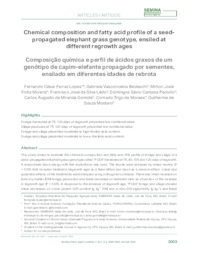Chemical composition and fatty acid profile of a seed-propagated elephant grass genotype, ensiled at different regrowth ages.
Chemical composition and fatty acid profile of a seed-propagated elephant grass genotype, ensiled at different regrowth ages.
Resumo: This study aimed to evaluate the chemical composition and fatty acid (FA) profile of forage and silage of a seed-propagated elephant grass genotype called ?PCEA? harvested at 75, 90, 105 and 120 days of regrowth. A randomized block design with five replications was used. The results were analyzed by mixed models (P < 0.05) that included treatment (regrowth age) as a fixed effect and block as a random effect. Linear and quadratic effects of the treatments were analyzed using orthogonal contrasts. There was linear increase on total dry matter (DM) forage production and linear decrease on leaf:stem ratio as a function of the increase in regrowth age (P < 0.05). In response to the advance of regrowth age, ?PCEA? forage and silage showed linear decreases on crude protein (CP) content (g kg-1 DM) and in vitro DM digestibility (g kg-1); and linear increases on DM (g kg-1), lignin (g kg-1 DM), and acid detergent insoluble protein (%CP) contents (P < 0.05). All ?PCEA? silages had DM content < 200 g kg-1, pH > 4.0, and ammonia N content > 10% total N. In response to the advance of regrowth age, linear decreases (P < 0.05) were observed on forage and silage linoleic, α-linolenic, and total FA contents (g kg-1 DM). From 75 to 120 days of regrowth, the seed-propagated elephant grass genotype ?PCEA? presents forage and silage with low nutritional quality for feeding dairy cattle, moderate to high linoleic acid contents, and moderate to low α-linolenic acid contents. The ?PCEA? forage and silage obtained from 75 to 120 days of regrowth presents low potential for production of milk naturally enriched with bioactive FAs beneficial to human health.
Ano de publicação: 2022
Tipo de publicação: Artigo de periódico
Unidade: Embrapa Gado de Leite
Observações
1 - Por padrão são exibidas publicações dos últimos 20 anos. Para encontrar publicações mais antigas, configure o filtro ano de publicação, colocando o ano a partir do qual você deseja encontrar publicações. O filtro está na coluna da esquerda na busca acima.
2 - Para ler algumas publicações da Embrapa (apenas as que estão em formato ePub), é necessário ter, no celular ou computador, um desses softwares gratuitos. Sistemas Android: Google Play Livros; IOS: iBooks; Windows e Linux: software Calibre.
Acesse outras publicações
Acesse a Base de Dados da Pesquisa Agropecuária (BDPA) para consultar o acervo completo das bibliotecas da Embrapa.

